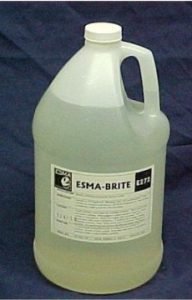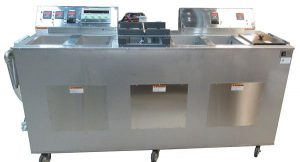What is an Electropolishing Solution?
Electropolishing is a popular electrochemical process used to polish and deburr metal surfaces. It is commonly used in industries such as medical device, aerospace and automotive to improve the smooth appearance and corrosion resistance of metal parts. One of the key components in the electropolishing process is the electrolyte solution, which consists of specific chemicals and additives that are essential for achieving the desired surface finish.
Electropolishing solutions are formulated to provide the right balance of electrical conductivity, ion transfer, and surface reactivity to effectively remove surface imperfections and enhance the overall surface finish of the metal substrate. These electrolyte chemicals play a crucial role in the success of the electropolishing process and can greatly impact the quality and consistency of the final polished surface.
For details on the electropolishing process, please see our article What is Electropolishing? How Does Electropolishing Work?
Benefits of Electropolishing Chemicals
Traditional mechanical finishing systems can scratch or dent the metal surface due to part-on-part contact. Electropolishing, on the other hand, removes metal from the surface in a way that prevents part-on-part contact, while also making the surface smoother and in some cases highly reflective. Furthermore, it enhances the corrosion resistance and passivity of many types of ferrous and nonferrous alloys. This process involves both micro-polishing, which creates brightness, and macro-polishing, which creates smoothness in the metal part.
Key benefits include:
- Improve corrosion resistance
- Deburr parts with complex geometry
- Reduce friction with polished smooth surface
- Ultra-clean metal surface
- Extend life of product through stress relief
- Decorative appearance with mirror finish
How to Choose the Right Electropolishing Electrolyte Solution
The most important consideration when choosing an electropolishing solution is identifying the metal substrate. Some electropolishing solutions support a broader range of alloys than others. Note: Never mix different grades of steel or different metals in the same electropolishing bath. The differing galvanic potentials can lead to galvanic corrosion.
Ambient humidity also impacts choice of electropolishing electrolyte solution. More humidity means more electrical resistance, and impacts the viscosity of the electropolishing fluid. Geographic areas with high humidity may need to compensate by using higher working temperatures.
Other factors that differentiate electrolyte options include the working temperature, aggression rate, desired finish, and environmental and safety considerations.
Which Electropolishing Solution is Right for You?
Best Technology offers a full range of electropolishing solutions to meet your electropolish chemical needs. The first step is to identify the metal or alloy that you will be working with. Below is a sample of our top-selling BestSolv™ electropolishing solutions for stainless steel and other metals. If you’re not finding a match for your material on this chart, contact us for more information about other solution options that may work for you.
Electropolishing Solution Product Comparison
| Product Name | Best For | Operating Temperature Range | Specific Gravity (new solution) |
| BestSolv-EP Esma E972 Stainless Steel EP |
| 120 – 150 °F (49 – 66 °C) | 1.24 – 1.49 |
| BestSolv-EP Esma E6040 Stainless Steel EP |
| 120 – 140 °F (49 – 60 °C) | 1.76-1.81 |
| BestSolv-EP Esma E1005 Brass EP | Brass | 120 – 140 °F (49 – 60 °C) | 1.24 |
| BestSolv-EP Esma E272 Esma Brite | Mild electrolyte for cobalt-chrome | 120 °F (50 °C) | 1.24 |
| BestSolv-EP EPS 4000 |
| 150 – 210 °F (66 – 99 °C) | 1.74 – 1.77 |
| BestSolv-EP EPS 2500 |
| 90 – 150 °F (32 – 66 °C) | 1.73 – 1.75 |
| BestSolv-EP EPS 1375 |
| 140 – 180 °F (60 – 82 °C) | 1.47 – 1.49 |
Common Applications for Electropolishing Solutions
Applications using electropolishing electrolyte solutions include the following:
- Medical device stent polishing and deburring of stainless steel and cobalt chrome
- Industrial stainless steel series polishing to reduce surface roughness and burr removal
- Reducing friction and ensuring top performance on flight-critical aerospace parts
- Reducing friction, boosting performance and extending life on automotive and racing industry parts
Electropolishing FAQs
-
What is electropolishing?
Electropolishing is an electrochemical process that removes material from a metallic part, typically stainless steel or similar alloys. The part is immersed in a temperature controlled bath of electrolyte (typically mixtures of sulfuric acid and phosphoric acid). The part serves as the anode as it is connected to the positive terminal of a DC power rectifier. The negative terminal of the rectifier is attached to the cathode which is typically made from titanium or other alloys which do not dissolve during the electropolishing process.
Visit What is electropolishing? How does electropolishing work? for more detailed information on electropolishing.
-
What’s the difference in passivation and electropolishing?
As a non-electrolytic process, passivation uses solutions like citric and nitric acids instead of an electrical current used in electropolishing to create a inert oxide layer / film and remove free iron and foreign matter from metal surfaces.
Electropolishing, a non-mechanical interactive process, can be used on objects with complex geometries. The electropolishing process uses a combination of electrolytic chemicals and an electrical current to carefully eliminate imperfections and contaminants of metal part surfaces. This particular process is an alternative to abrasive fine polishing.
Electropolishing can be used to polish, deburr, and smooth metal components whereby doing so also causes material removal to occur including the free irons on the surface of the part. Electropolishing would be the more appropriate approach when aesthetics are necessary. A smoother, polished surface can result from electropolishing.
Passivation, on the other hand, does not change or brighten the surface appearance, and is not an effective method for improving surfaces that have been welded with oxide heat effect scale or heat treated.
-
How many amps of current will it take to electropolish a part?
The current or amps required to electropolish a part is primarily based on the surface area of the part or total surface area if multiple parts are desired to be electropolished at the same time. More information on electropolishing can be found on What is electropolishing? How does electropolishing work? page
Visit the Electropolishing Current Required Calculation Spreadsheet to calculate the approximate current amperage required for electropolishing
-
How long will it take to electropolish a part?
The cycle time required to electropolish a part is primarily based on the current / amps and surface area of the part or total surface area and rectifer current if multiple parts are desired to be electropolished at the same time.
Visit the Electropolishing Current Required Calculation Spreadsheet to calculate the approximate cycle time required for a part or total parts for electropolishing.
What is electropolishing? How does electropolishing work? contains more in depth information on electropolishing.
Electropolishing Equipment
Best Technology offers industry-leading electropolishing equipment. To learn more, visit the Electropolishing Equipment section of our website.
Electropolishing Solutions Price and Ordering
Please contact our chemical sales department for a quote on electropolishing solutions by clicking the “Get a Quote” button, or call 612-392-2414, ext. 2.


